Apple A1421 802.11a/b/g/n and Bluetooth Radio User Manual RF Exposure Web draft for TCB 120817 MTM v1 0 key
Apple Inc. 802.11a/b/g/n and Bluetooth Radio RF Exposure Web draft for TCB 120817 MTM v1 0 key
Apple >
Contents
Regulatory Info from Web

Apple Confidential
RF Exposure Web Site Draft
Last updated: August 17, 2012
1
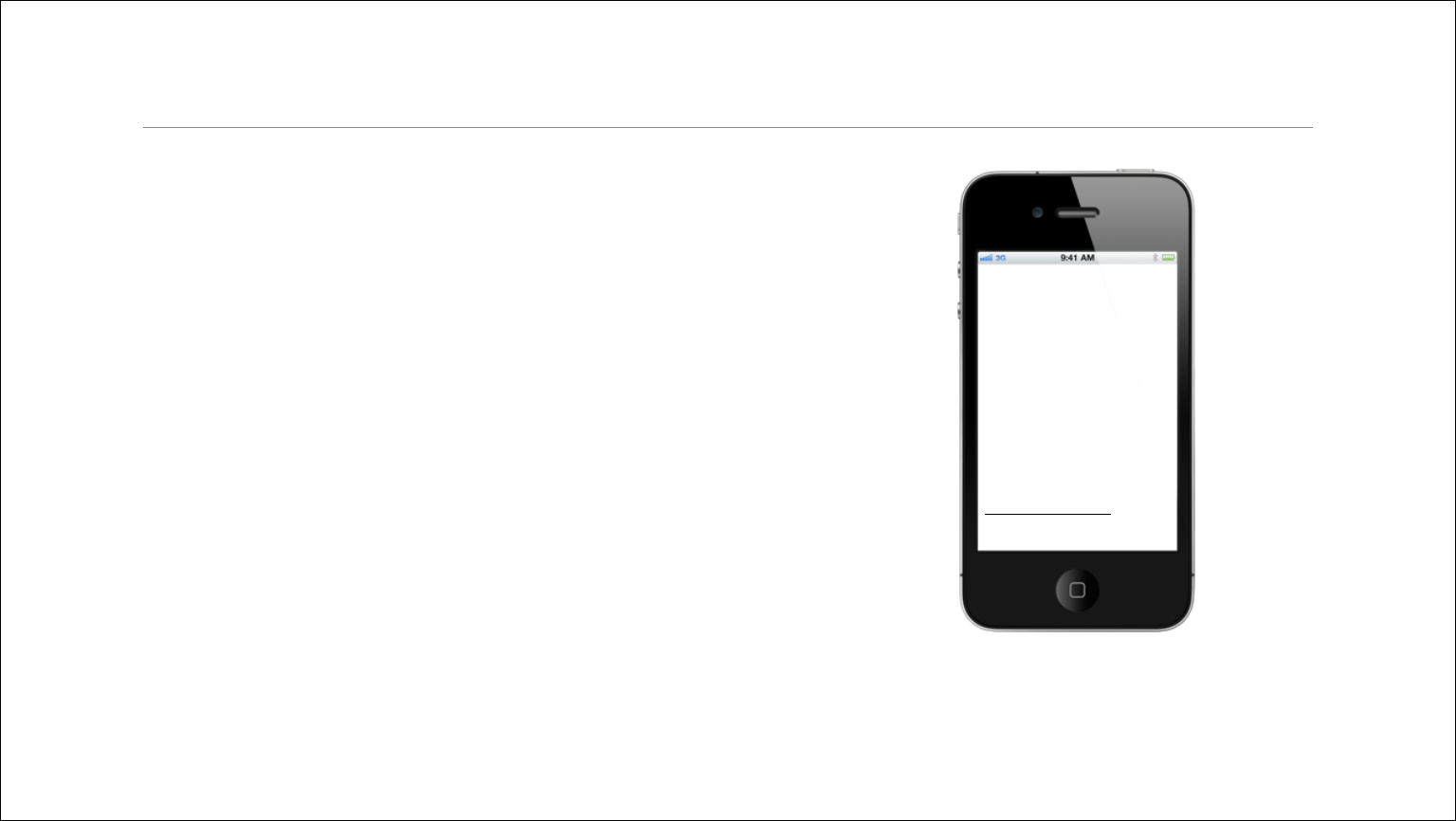
Apple Confidential
■On-device information:
-On Device page will include pointer to web
page for device-specific & language-specific
SAR information
-Currently being implemented in iOS 6
■Online page:
-Contains device-specific SAR numbers (see
next slide for details)
Overview
iPhone has been tested and meets applicable
limits for Radio Frequency (RF) exposure.
Specific Absorption Rate (SAR) refers to the rate at
which the body absorbs RF energy. Mobile phone
SAR limits are 1.6 watts per kilogram (over a
volume containing a mass of 1 gram of tissue) and
2.0 watts per kilogram (averaged over 10 grams of
tissue), depending on country. During testing,
iPhone radios are set to their highest transmission
levels and placed in positions that simulate use
against the head, with no separation, and near the
body, with 10 mm separation.
To reduce exposure to RF energy, decrease talk
time or use a hands-free option, such as the built-
in speakerphone, the supplied headphones, or
other similar accessories.!Carry iPhone at least 10
mm away from your body to ensure exposure
levels remain at or below maximum levels. Avoid
cases with metal parts.
More information on RF Exposure, including SAR
values for this device, is available at:
www.apple.com/legal/rfexposure
2
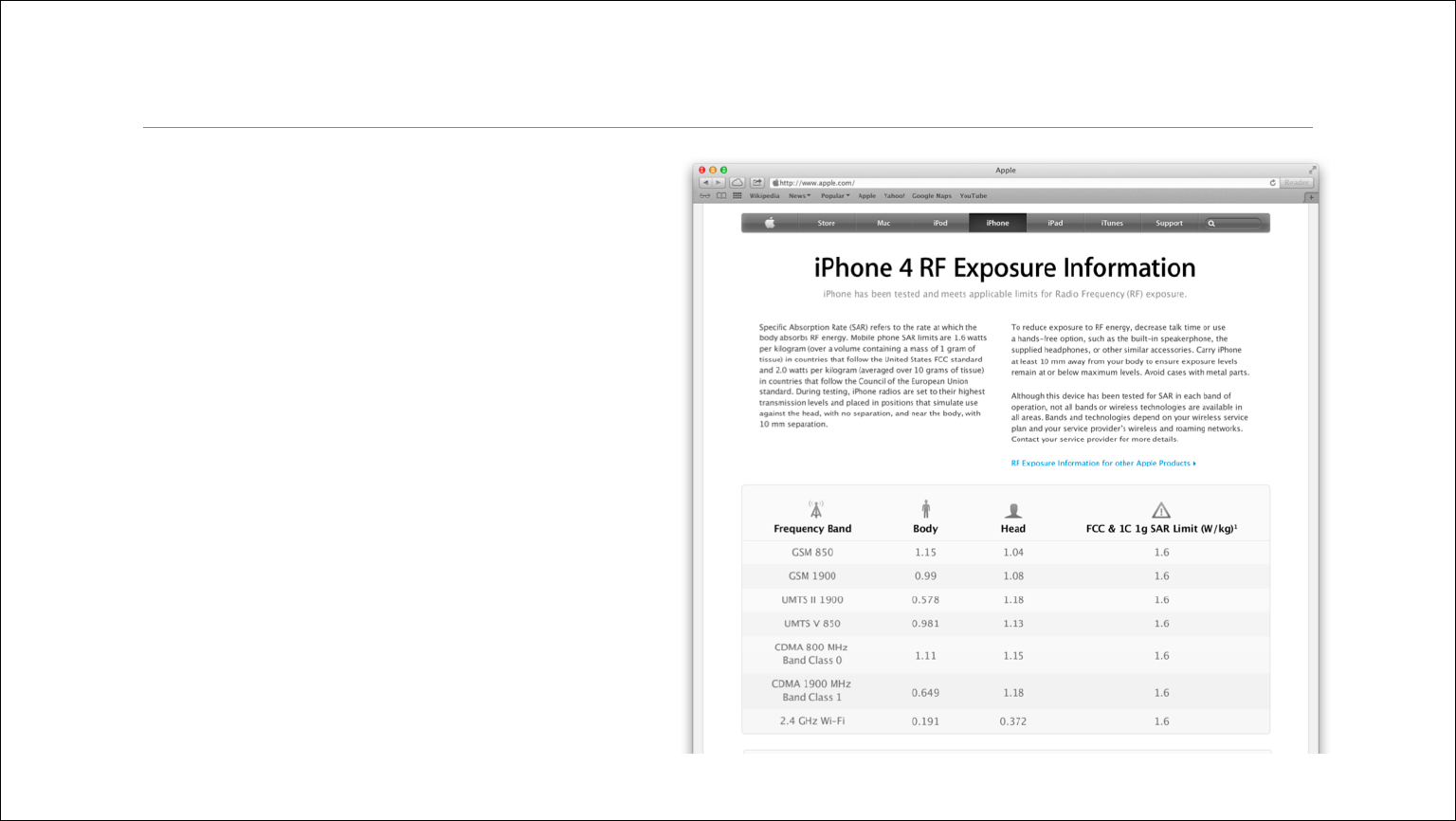
Apple Confidential
Sample RF Exposure Web page DRAFT
3
Contains:
■Title identifies product
■Repeats RF warning text
from the device
■Contains Table of SAR
information
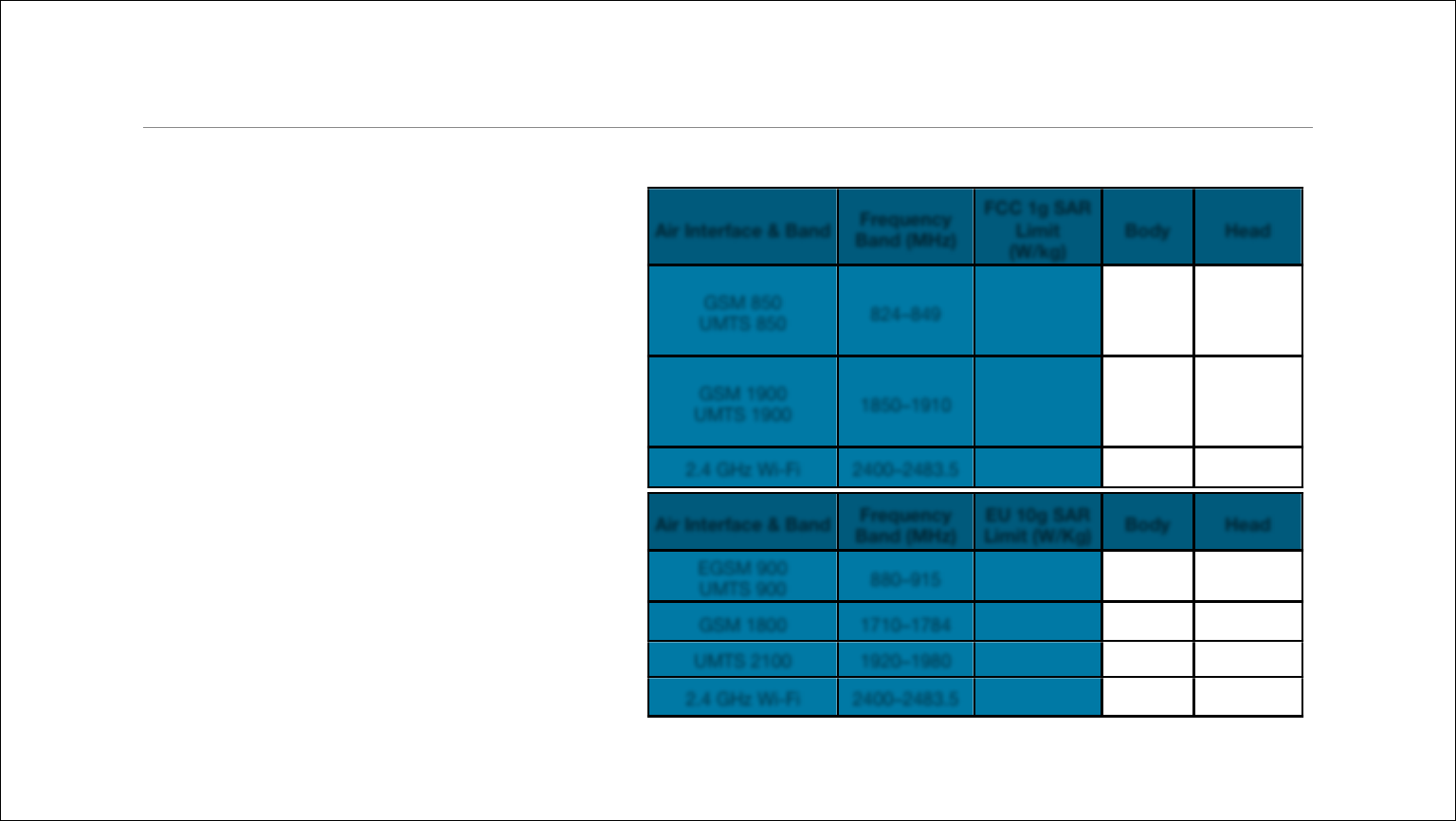
Apple Confidential
Sample SAR Page Content –"iPhone 3GS
4
Air Interface & Band
Frequency
Band (MHz)
FCC 1g SAR
Limit
(W/kg)
Body
Head
GSM 850
UMTS 850
824–849
GSM 1900
UMTS 1900
1850–1910
2.4 GHz Wi-Fi
2400–2483.5
1.6
0.67
0.63
1.6
0.33
1.19
1.6
0.06
0.52
Air Interface & Band
Frequency
Band (MHz)
EU 10g SAR
Limit (W/Kg)
Body
Head
EGSM 900
UMTS 900
880–915
GSM 1800
1710–1784
UMTS 2100
1920–1980
2.4 GHz Wi-Fi
2400–2483.5
2.0
0.45
0.40
2.0
0.19
0.72
2.0
0.42
1.10
2.0
0.04
0.24
■Final SAR web page will
consolidate bands as
much as possible, per
the table to the right
■The purpose is to make
the information more
accessible to consumers
by consolidating the rows
where possible
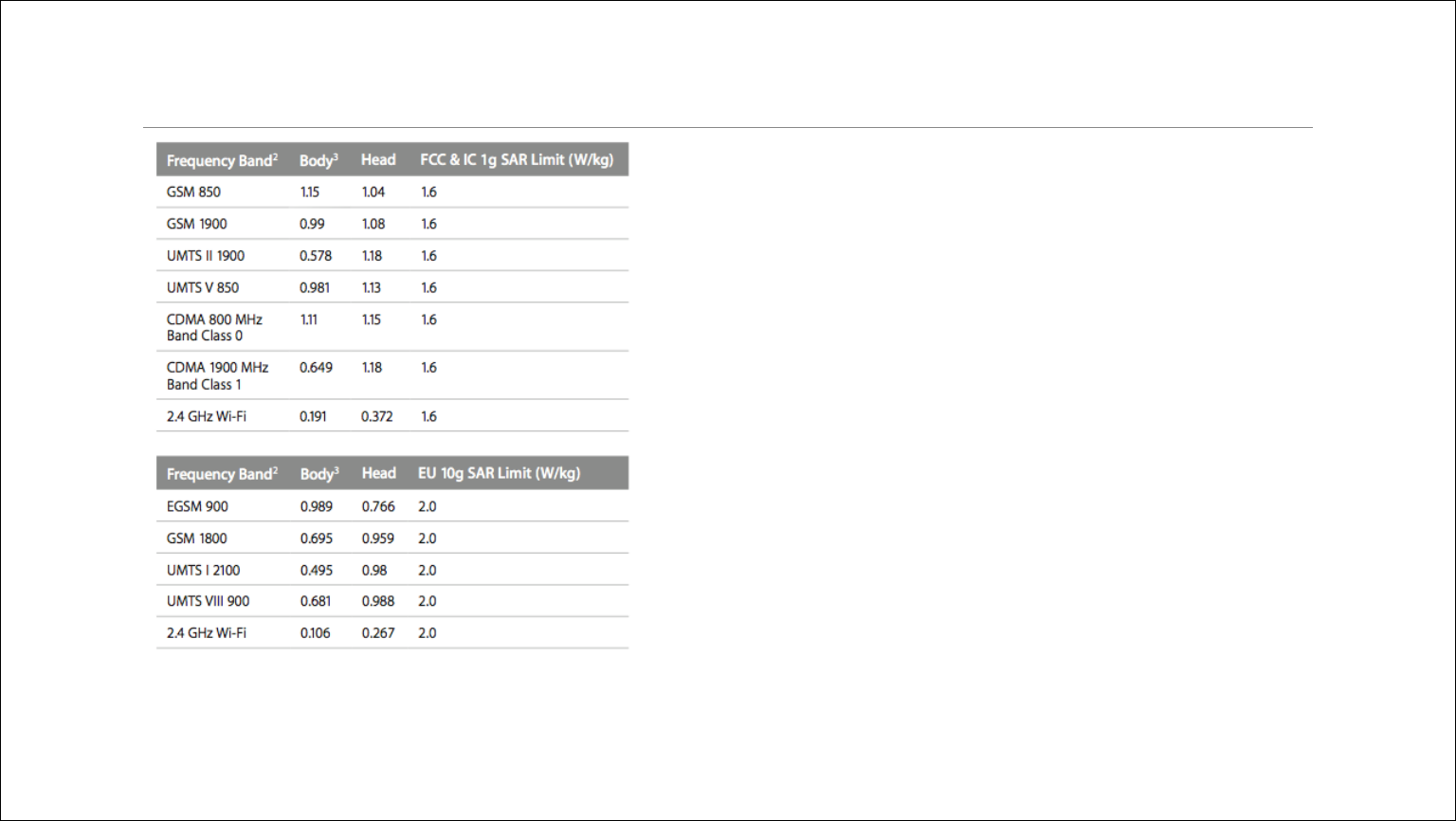
Apple Confidential
Footnotes on Each Web Page
■fn1 –!FCC OET Bulletin 65,
Supplement C (Edition 01-01) &
IEEE 1528-2003, & Canada RSS
102, Issue 4, March 2010.
■fn2 – European Council
Recommendation of 12 July
1999 on the Limitation of
Exposure of the General Public
to Electromagnetic Fields
[1999/519/EC].
1
2
5
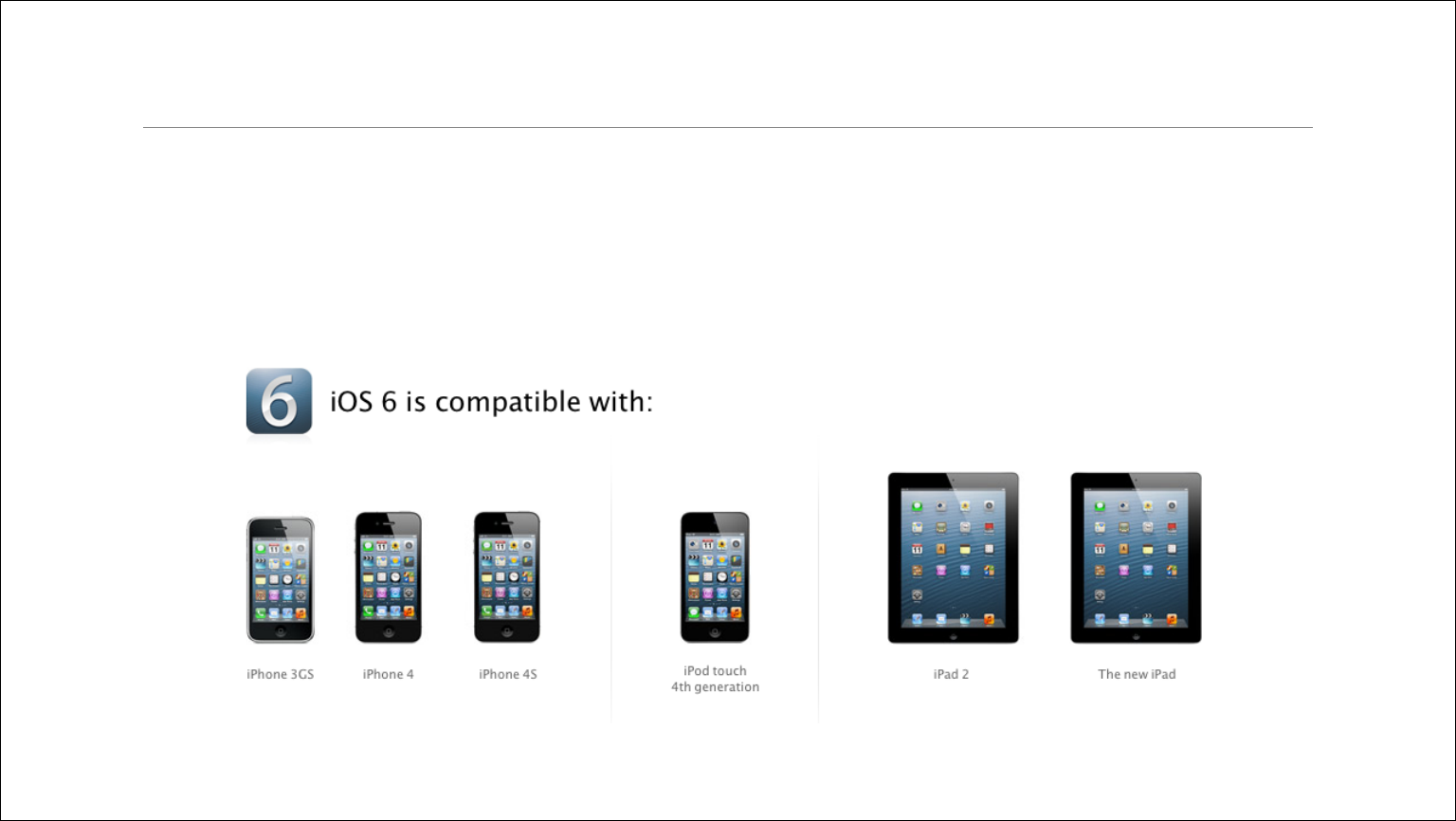
Apple Confidential
Approach Only for iOS 6 Devices
■All devices capable of running iOS 6 (see below)
■Plus Fall-release iOS devices (A18, A19, A21, C1x)
6

Apple Confidential
Localized by iOS Languages
■English / Universal Default – English Language plus universal icons
■iOS languages: French (France), German, Traditional Chinese,
Simplified Chinese, Dutch, Italian, Spanish, Portuguese (Brazil),
Portuguese (Portugal), Danish, Swedish, Finnish, Norwegian,
Korean, Japanese, Russian, Polish, Turkish, Ukrainian, Hungarian,
Arabic, Thai, Czech, Greek, Hebrew, Indonesian, Malay, Romanian,
Slovak, Croatian, Catalan, and Vietnamese
7
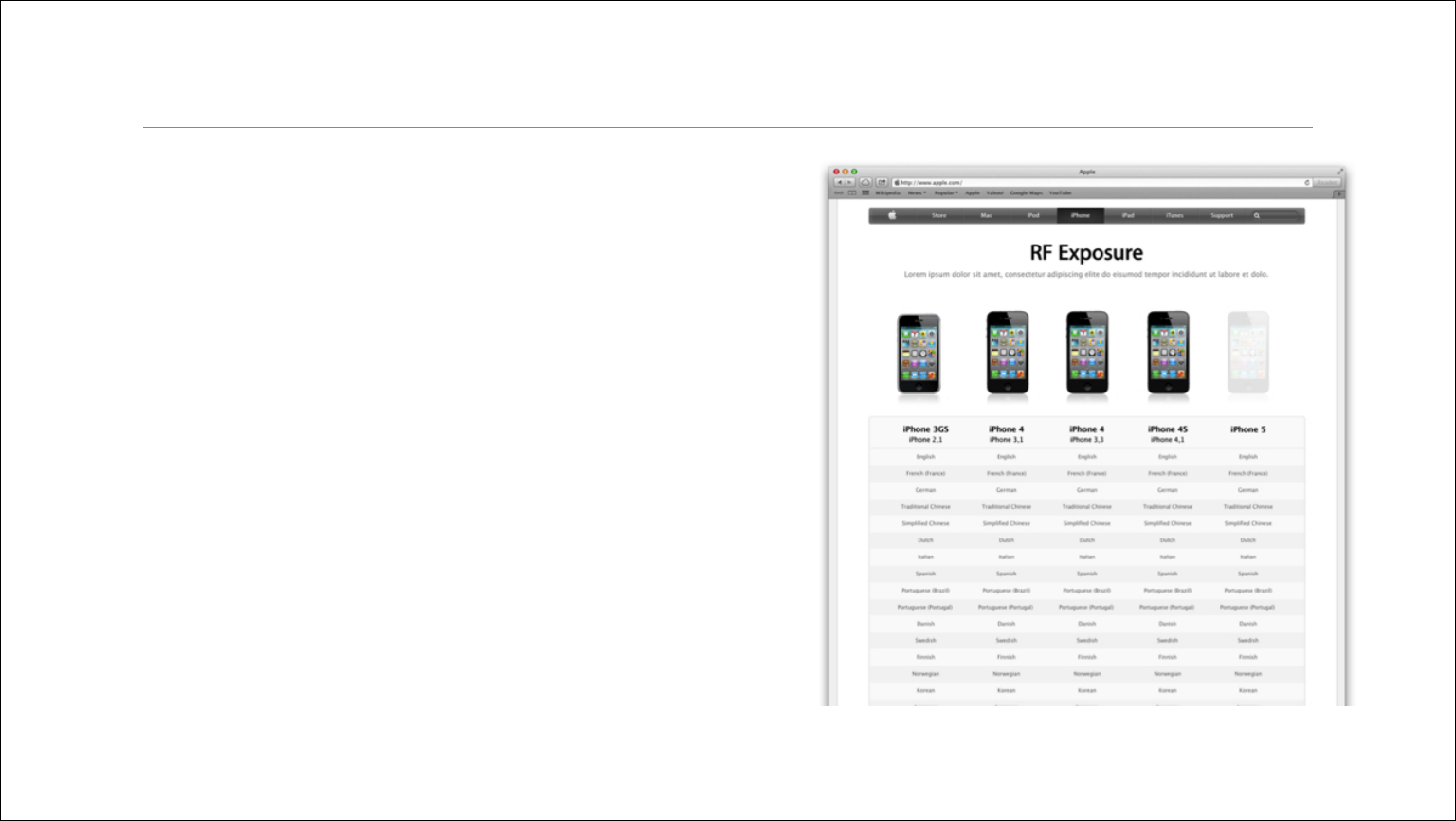
Apple Confidential
■General landing page accessible
from web site
-Contains pointers to device-
specific SAR information
General access via web
8

Apple Confidential
RF Exposure Statements for device & web
9

Apple Confidential
iPhone RF Exposure Statement
iPhone has been tested and meets applicable limits for Radio Frequency (RF) exposure.
Specific Absorption Rate (SAR) refers to the rate at which the body absorbs RF energy. SAR limits are 1.6
Watts per Kilogram (over a volume containing a mass of 1 gram of tissue) in countries that follow the United
States FCC limit and 2.0 W/Kg (averaged over 10 grams of tissue) in countries that follow the Council of the
European Union limit. During testing, iPhone radios are set to their highest transmission levels and placed in
positions that simulate use against the head, with no separation, and near the body, with 10 mm separation.
To reduce exposure to RF energy, use a hands-free option, such as the built-in speakerphone, the supplied
headphones, or other similar accessories.!Carry iPhone at least 10 mm away from your body to ensure
exposure levels remain at or below the as-tested levels. Cases with metal parts may change the RF
performance of the device, including its compliance with RF exposure guidelines, in a manner that has not
been!tested or certified.
SAR values for this device are available at: www.apple.com/legal/rfexposure/[MODEL]
Although this device has been tested to determine SAR in each band of operation, not all bands are available
in all areas. Bands are dependent on your service provider’s wireless and roaming networks.
10

Apple Confidential
iPad RF Exposure Statement
iPad has been tested and meets applicable limits for Radio Frequency (RF) exposure.
Specific Absorption Rate (SAR) refers to the rate at which the body absorbs RF energy. SAR limits
are 1.6 Watts per Kilogram (over a volume containing a mass of 1 gram of tissue) in countries that
follow the United States FCC limit and 2.0 W/Kg (averaged over 10 grams of tissue) in countries
that follow the Council of the European Union limit. During testing, iPad radios are set to their
highest transmission levels and placed in positions that simulate use against the body. Cases with
metal parts may change the RF performance of the device, including its compliance with RF
exposure guidelines, in a manner that has not been!tested or certified.
[FOLLOWING TEXT FOR CELLULAR VERSION ONLY] SAR values for this device are available
at: www.apple.com/legal/rfexposure/[MODEL]
Although this device has been tested to determine SAR in each band of operation, not all bands
are available in all areas. Bands are dependent on your service provider’s wireless and roaming
networks.
11

Apple Confidential
iPod touch RF Exposure Statement
iPod touch has been tested and meets applicable limits for Radio
Frequency (RF) exposure.
Specific Absorption Rate (SAR) refers to the rate at which the body absorbs
RF energy. SAR limits are 1.6 Watts per Kilogram (over a volume containing
a mass of 1 gram of tissue) in countries that follow the United States FCC
limit and 2.0 W/Kg (averaged over 10 grams of tissue) in countries that
follow the Council of the European Union limit. During testing, iPod touch
radios are set to their highest transmission levels and placed in positions
that simulate use against the body. Cases with metal parts may change the
RF performance of the device, including its compliance with RF exposure
guidelines, in a manner that has not been!tested or certified.
12

Apple Confidential
iPod nano RF Exposure Statement
[PRINT ONLY - NOT ON DEVICE]
iPod nano has been tested and meets applicable limits for Radio Frequency (RF)
exposure.
Specific Absorption Rate (SAR) refers to the rate at which the body absorbs RF
energy. SAR limits are 1.6 Watts per Kilogram (over a volume containing a mass of 1
gram of tissue) in countries that follow the United States FCC limit and 2.0 W/Kg
(averaged over 10 grams of tissue) in countries that follow the Council of the
European Union limit. During testing, iPod nano radios are set to their highest
transmission levels and placed in positions that simulate use against the body. Cases
with metal parts may change the RF performance of the device, including its
compliance with RF exposure guidelines, in a manner that has not been!tested or
certified.
13